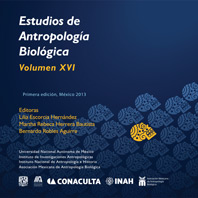Frecuencias de un alelo del gen EDAR en totonacos de la sierra Norte de Puebla y mestizos de la ciudad de México
DOI:
https://doi.org/10.22201/iia.14055066p.2013.56708Palabras clave:
EDAR, diente en pala, genética de poblaciones, genética cuantitativaResumen
El gen receptor-A de la ectodisplasina (EDAR) es importante en el desarrollo de algunos órganos, especialmente aquellos de origen ectodérmico. Una de las variantes no sinónimas del gen EDAR (V370A, T1540C, rs3827760) es exclusiva de Asia y América, donde alcanzó una alta frecuencia probablemente por selección positiva. Recientemente, el alelo 1540C ha sido asociado a los dientes en forma de pala en grupos humanos de Japón, en los cuales se estimó que describe aproximadamente 19 % de la diversidad fenotípica de este rasgo. En este trabajo estudiamos 91 individuos totonacos no emparentados procedentes de la sierra Norte de Puebla, 53 mestizos de la ciudad de México, con el propósito de reportar las frecuencias genéticas de este polimorfismo. Nuestros resultados muestran diferencias significativas (p < .01) de la frecuencia del alelo 1540C entre la población totonaca (.88) y mestiza (.48). Estos resultados son consistentes con las altas frecuencias del alelo 1540C observadas en las poblaciones del noreste asiático y con la frecuencia en las poblaciones nativas de América. Además, hemos observado que los datos no se encuentran en equilibrio Hardy-Weinberg en la población totonaca, lo que sugiere procesos de endogamia en un sector de esta comunidad que se reflejan en estructuras poblacionales. Por último, se analiza la frecuencia de este polimorfismo y la incidencia del diente en pala para discutir los mecanismos evolutivos de las poblaciones indígenas de América.
Descargas
Descargas
Publicado
Cómo citar
Número
Sección
Licencia

http://creativecommons.org/licenses/by-nc-nd/4.0/


